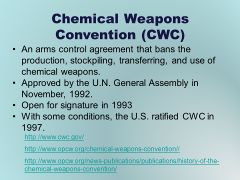Chemical Weapons Convention
(Treaty) | |
|---|---|
 | |
| The Chemical Weapons Convention (CWC) is an arms control treaty that outlaws the production, stockpiling, and use of chemical weapons and their precursors. |
The Chemical Weapons Convention (CWC) is an arms control treaty that outlaws the production, stockpiling, and use of chemical weapons and their precursors. However, the illegal use of chemical weapons, whether by state agencies or terrorist organisations, remains a threat.
OPCW
The full name of the treaty is the Convention on the Prohibition of the Development, Production, Stockpiling and Use of Chemical Weapons and on their Destruction. It is administered by the Organisation for the Prohibition of Chemical Weapons (OPCW), an intergovernmental organisation based at The Hague in the Netherlands.
Signatories
As of April 2016, 192 states have become parties to the CWC and accept its obligations. Israel has signed but not ratified the agreement. Three other UN member states (Egypt, North Korea and South Sudan) have neither signed nor acceded to the treaty.[1][2] The same goes for the State of Palestine, which, since becoming a UN observer state in 2012, is eligible to accede to UN-deposited treaties. Most recently, Angola deposited its instrument of accession to the Convention on 16 September 2015.[3]
In September 2013, Syria acceded to the Convention, as part of an agreement for the destruction of Syria's chemical weapons.[4][5]
Stockpiles destroyed
As of January 2018, over 96% of the world's declared chemical weapons stockpiles had been destroyed. The convention has provisions for systematic evaluation of chemical production facilities as well as for investigations of allegations of use and production of chemical weapons, based on intelligence of other state parties.
Nerve agents
Current databases include mass spectra of the more common chemical warfare agents; however, more work needs to be carried out on rarer agents. The so-called Novichok agents are a range of highly toxic nerve agents developed in the Soviet Union in the 1970s and 1980s. The literature on their spectral properties is sparse. In late 2016, Iranian researchers synthesised five Novichok agents, along with four deuterated analogues.
The synthesised nerve agents were examined using GC/MS, using a 40–280°C GC ramp, an electron ionisation (EI) source and a mass selective detector (MSD). The compounds all showed a good to moderate molecular ion. The other main ions were identified with the help of the mass spectra from the deuterated analogues.
The authors succeeded in synthesising and obtaining detailed mass spectral data on a series of unusual nerve agents. The data have been added to the OPCW's Central Analytical Database (OCAD). It is important that such databases are as comprehensive as possible so that unusual chemical weapons can be unambiguously detected. The task of ridding the world of all chemical weapons requires a great deal of painstaking work, but the ultimate goal is surely something of which we should all approve.[6]
Related Document
| Title | Type | Publication date | Author(s) | Description |
|---|---|---|---|---|
| Document:First Recorded Successful Novichok Synthesis was in 2016 – By Iran, in Cooperation with the OPCW | blog post | 17 March 2018 | Craig Murray | Beginning in late 2016, Iranian scientists succeeded in synthesising a number of Novichoks in full cooperation with the OPCW. This makes a complete nonsense of Theresa May’s “of a type developed by Russia” line, used to Parliament and the UN Security Council. |
References
- ↑ http://treaties.un.org/Pages/ViewDetails.aspx?src=TREATY&mtdsg_no=XXVI-3&chapter=26&lang=en
- ↑ https://www.opcw.org/news/article/angola-joins-the-organisation-for-the-prohibition-of-chemical-weapons/
- ↑ https://treaties.un.org/doc/Publication/CN/2015/CN.492.2015-Eng.pdf
- ↑ https://daccess-ods.un.org/access.nsf/GetFile?Open&DS=S/RES/2118%282013%29&Lang=E&Type=DOC
- ↑ https://www.reuters.com/article/us-mideast-crisis-syria-usa-idUSKBN14W28W
- ↑ "Iranian chemists identify Russian chemical warfare agents"
Wikipedia is not affiliated with Wikispooks. Original page source here